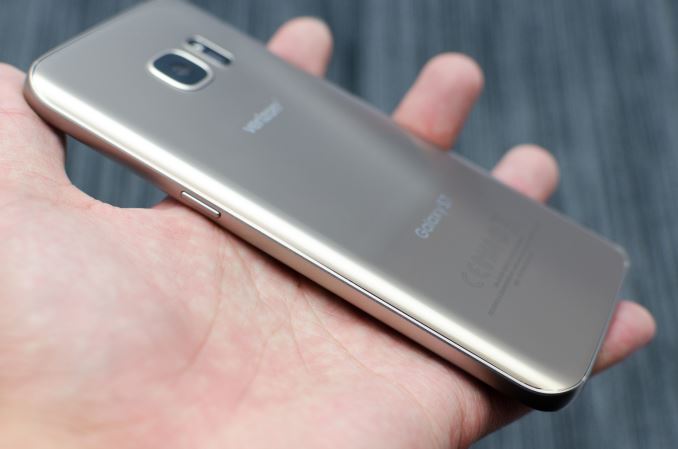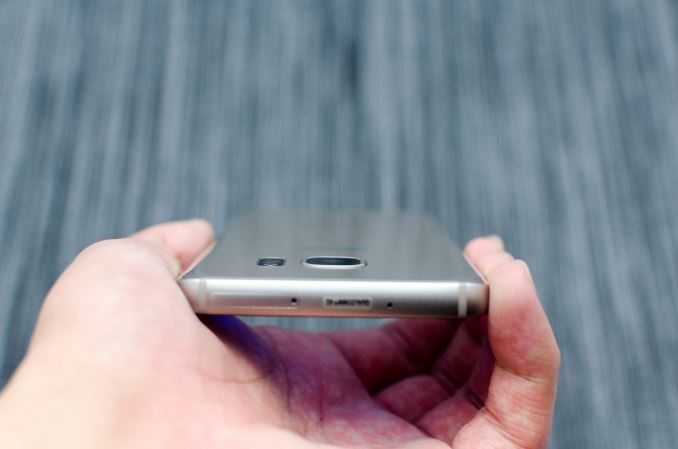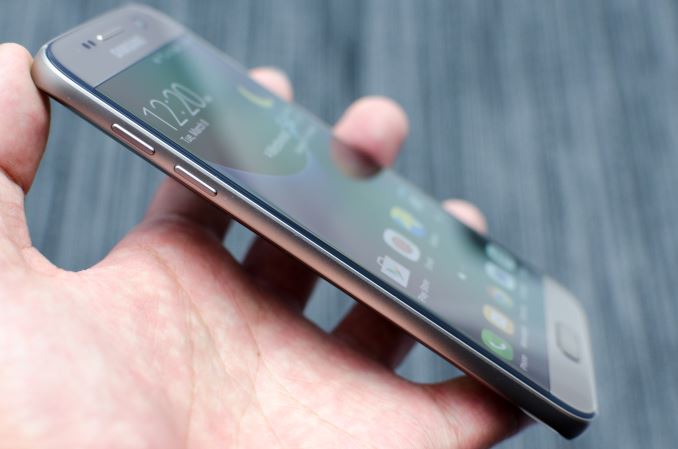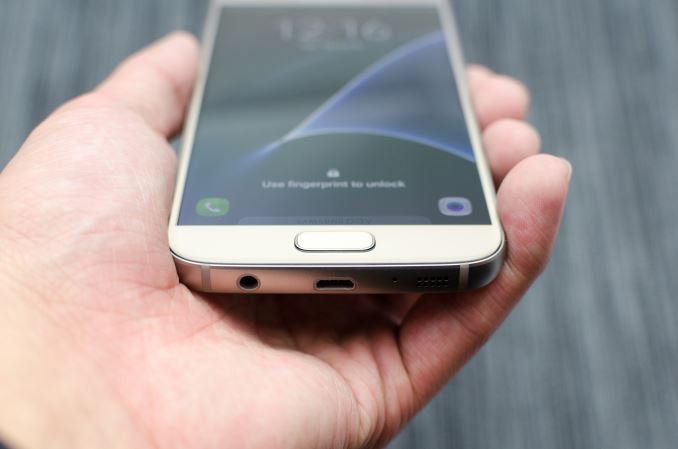The Samsung Galaxy S7 & S7 Edge Review, Part 1
by Joshua Ho on March 8, 2016 9:00 AM EST
For some time now, Samsung has been the dominant player in the Android space, especially at the high end of the market. From the Galaxy S2 onwards, Samsung has been able to ride the wave of the smartphone industry’s growth without much disruption. Samsung has also shown a pretty impressive ability to adapt to changes in the market as seen by their dramatic departure in materials from the Galaxy S5 generation to the Galaxy S6 generation. While the Galaxy S6 was ultimately one of the best phones you could get that year, at least a few design decisions like the loss of removable battery and microSD slot were generally considered to be a step back relative to previous devices.
Throughout their reign of dominance Samsung has always been able to stay on top, however their competition is never too far behind. To that end, it’s probably obvious now that the Galaxy S7 family represents an attempt to improve on the Galaxy S6’s perceived faults, while building upon its perceived strengths. In order to start discussing these changes, we can start by looking at the basic specs and design of the Galaxy S7 and S7 edge.
| Samsung Galaxy S Family | |||||
| Samsung Galaxy S7 | Samsung Galaxy S7 edge | Samsung Galaxy S6 | Samsung Galaxy S6 edge | ||
| SoC | Snapdragon 820 (US, China, Japan) 2x Kryo @ 2.15GHz 2x Kryo @ 1.6GHz Adreno 530 Exynos 8890 (Rest of World) 4x A53 @ 1.58GHz 4x Exynos M1 @ 2.28-2.60GHz Mali T880MP12 @ 650MHz |
Exynos 7420 4x Cortex-A57 @ 2.1GHz 4x Cortex-A53 @ 1.5GHz Mali T760MP8 |
|||
| RAM | 4GB LPDDR4-3600 | 3GB LPDDR4-3100 | |||
| NAND | 32/64GB NAND (UFS) + microSD |
32/64/128GB NAND (UFS) | |||
| Display | 5.1” 1440p SAMOLED |
5.5" 1440p SAMOLED Dual Edge |
5.1” 1440p SAMOLED |
5.1” 1440p SAMOLED Dual Edge |
|
| Network | S820: Qualcomm X12 Integrated 2G / 3G / 4G LTE (Category 12/13) |
2G / 3G / 4G LTE (Category 6) | |||
| Dimensions | 142.4 x 69.6 x 7.9 mm, 152 grams | 150.9 x 72.6 x 7.7 mm, 157 grams | 143.4 x 70.5 x 6.8mm max, 138 grams | 142.1 x 70.1 x 7.0mm max, 132 grams | |
| Camera | Rear Camera w/OIS 12MP (4032 x 3024) Sony IMX260 f/1.7, object tracking AF |
Rear Camera w/OIS 16MP (5132 x 2988) Sony IMX240 / Samsung S5K2P2 f/1.9, object tracking AF |
|||
| Front Facing 5MP, f/1.7 |
Front Facing 5MP , f/1.9 |
||||
| Battery | 3000mAh (11.55 WHr) | 3600mAh (13.86 WHr) | 2550 mAh (9.81 WHr) | 2600 mAh (10.01 WHr) | |
| Launch OS | Android 6 w/TouchWiz | Android 5 w/TouchWiz | |||
| Connectivity | 802.11a/b/g/n/ac 2x2 MU-MIMO + BT 4.2, USB2.0, GPS/GNSS, NFC |
2x2 802.11a/b/g/n/ac + BT 4.1 (BCM4358), USB2.0, GPS/GNSS, NFC |
|||
| Wireless Charging | Yes, Fast Charging | WPC 1.1 (4.6W) & PMA 1.0 (4.2W) |
|||
| Fingerprint Sensor | Touch | Touch | |||
| SIM Size | NanoSIM | NanoSIM | |||
| Launch Price (No Contract) |
$650+ USD | $750+ USD | $650+ USD |
$750+ USD |
|
One of the other major changes in terms of design this time around is electing to go with a significantly larger battery than before. Compared to most other aspects of smartphone technology, battery technology is a more mature field and improves as a slower pace, so the tradeoffs made here result in a thicker device and increased weight relative to the Galaxy S6. However, as we’ll soon see Samsung has made a number of changes in the industrial design which help to mitigate these issues.
Meanwhile, with the Galaxy S7 generation, Samsung has further blurred the line between the Galaxy S lineup and the Galaxy note. The Galaxy S7 edge is a 5.5-inch device - fully into the phablet territory - and only 0.2 inches smaller than the 5.7" Galaxy Note5. This means that the two Galaxy S7 phones are now more significantly differentiated than with the Galaxy S6 generation, where the difference amounted to the dual-edge display and a slightly larger battery. Now the Galaxy S7 edge is larger, ever so slightly heavier, and contains a battery with 20% more capacity than it's base Galaxy S7 brethren.
The final change of note in the Galaxy S7/S7 edge is the camera. With the Galaxy S6 review it was hard to avoid wondering why Samsung didn’t bother to integrate a camera with larger pixel size to improve low light performance, especially when camera was such a significant part of the Galaxy S6 design story with the noticeable camera hump. For the Galaxy S7, Samsung has gone ahead and done just this: the pixel size is now 1.4 micron which should significantly increase the number of situations where the image quality is limited by shot noise rather than image sensor noise. And to top things off the camera hump has now been almost entirely eliminated.
On a quick housekeeping note before we dive in, as we've had less than a week to look at the Galaxy S7, we're dividing up our review into two parts. Today we'll focus on the basics: performance, battery life, design, and the display. Part 2 will go deeper, looking into the Snapdragon 820 SoC in fuller detail, and coupling that with Wi-Fi performance, camera performance, and more.
Design
Now that we’ve gone over the high level changes of the Galaxy S7 and S7 edge, we can start talking about the design of the device. While the Galaxy S6 was an enormous departure from what we were used to seeing from Samsung, the Galaxy S7 is really more an evolution of the Galaxy S6 design. As previously mentioned, it is noticeably thicker and heavier than the Galaxy S6. However, to offset this increase in thickness Samsung has integrated the curved 3D glass of the Galaxy Note5 into the design of the Galaxy S7.
The result of this change is that the Galaxy S7 arguably feels much better in the hand than the Galaxy S6. While I didn’t really have huge issues with the ergonomics of the Galaxy S6, it definitely felt a bit blocky relative to something like the Xiaomi Mi Note Pro and didn’t quite fit in the hand as nicely. The weight increase is noticeable, but not really the end of the world.
The thickness does result in a noticeably reduced camera hump, but on a personal level I never really cared about the camera hump in the Galaxy S6, so I’m not sure I care about the reduction in the camera hump here. I would actually argue that a camera hump is preferable to a camera cover lens that is perfectly coplanar to the back of the phone, as it means that the camera lens isn’t contacting whatever surface I’ve set it down on. While sapphire cover lenses go a very long way to eliminating the potential for scratching a cover lens, there’s also the potential for oil to smear on the camera’s cover lens so I would actually prefer having a camera hump.
The other noticeable change here is the re-introduction of 2.5D curved glass on the edges of the display. I’m not quite sure why Samsung tends to remove and re-introduce this design element seemingly on and off, but it does help with improving the feel of edge swipes at the cost of complicating some things like screen protectors and glass lens durability. Honestly speaking, I’m not sure how much of a difference it makes either way, but it does remove another edge present in the design.
Other than these changes, the design is almost unchanged. The power button remains on the right side of the device and is well-positioned ergonomically. The volume buttons are pretty much in the same place on the left side as well. The 3.5mm jack, micro-USB port, and single speaker are all on the bottom of the device. The only notable deletion in terms of design elements here would be the loss of the IR port on top of the device, which was removed from Galaxy devices starting with the Note5.














202 Comments
View All Comments
Belard - Friday, March 11, 2016 - link
What I find shockingly stupid is the release of these new $600~900 phones, including the latest Moto X, that DO NOT include USB-C connector?! Its been available since last year.Apple does things quickly, they come out with technology and release it: such as with the iPhone 5 with its reversible port. How hard is it to do with other companies?
Motorola (Lenovo) could have done this with their New X to make a bold statement on how they are going to run their business.
theduckofdeath - Friday, March 11, 2016 - link
Probably because Samsung has usage data on what we actually use the USB port for these days. And I guess it's used almost exclusively as a charger. Why force the consumers to buy a bunch of new cables and chargers just because there is a new port out there? I know Apple would do that in a heartbeat, like you said, as they simply see it as a new way to increase earnings on licensing accessories.Azurael - Tuesday, March 15, 2016 - link
Because USB-C is much easier and quicker to connect? (I certainly find the 5X and 6P much easier to connect in a darkened room - good thing since Google nicked Qi charging.)Because USB-C cables and sockets should be (probably too early to say, but by design) far less prone to failure than Micro-B? (Micro-B cables, and not cheap ones - OEM LG/Nokia/Sony/Moto cables, die on me on a weekly basis. About half of the cables I own only work for charging now.)
I don't know, why don't we still connect our keyboards with the AT connector or PS/2, and our digital video cameras by firewire?
You don't need new chargers. If you've got dozens of USB-A power supplies, just use an A-C cable.
theduckofdeath - Tuesday, March 15, 2016 - link
I'm not suffering from long connection times when connecting my mobile to the charger. Sure, it would be nice with a more uniform connector, but, if it comes at the expense me having to throw away all old cables, having to bring adapters and generally making life more expensive, I can easily live with a micro USB connector until connectors are entirely a thing of the past.Physical connectors for data transfer is really not essential these days. These phones has wifi and LTE connectivity at speeds close enough to any USB connection to make us not bothering transferring anything by wire any more.
Belard - Tuesday, March 15, 2016 - link
Uh, just need to replace the cable or it comes with the phone... not difficult. A flip-able cable is VERY handy, especially in the dark. Unless the end is marked or molded a different shape - you have to LOOK which side is up. Apple changed the cable ONE time, because they wanted a much smaller and better connector.So for a top end phone, I want a state of the art connector too. hence, I bought a new Moto G for $220... I lose the stereo speakers, but I saved $200 and have two free color covers I switch out for when I'm in the mood. So maybe I'll stick with the Gs.
Bruce Dunn - Friday, March 11, 2016 - link
For the average cell phone buyer, most of the information in this review goes right over their heads. I hope that part 2 of the review will address in simple language the following:Can I read the display in direct sunlight (giving me the number of nits emitted by the display does not tell me this).
What happens if I drop the phone into a sink full of water.
What happens if I drop the phone onto a concrete floor.
peedroo - Saturday, March 12, 2016 - link
http://www.displaymate.com/Galaxy_S7_ShootOut_1.ht...Maximum screen brightness in high ambient light results
s.yu - Thursday, March 17, 2016 - link
Anandtech is not for the "average cell phone buyer". It's for people who *really want to know*. If there were more of us there would be less rip-off products on the market and everything would be easier, more money would be devoted to R&D instead of marketing and more will be achieved.peedroo - Saturday, March 12, 2016 - link
Loved the review till nowBut here
http://www.displaymate.com/Galaxy_S7_ShootOut_1.ht...
...they have tottaly diferent results about screen brightness levels when we compair it to the S6. It's better
karthik.hegde - Sunday, March 13, 2016 - link
I think what article needs to highlight more is that the Kirin 950 handily beats SD820 is most of the tests. ARM Cortex-A72 is a great core, released quite sometime ago still doing pretty well. I am sure ARM has new CPUs in the pipeline which will be released soon.I wonder if it makes sense for Qualcomm from business perspective to continue designing their own cores, while ARM already offers stock cores with great performance.